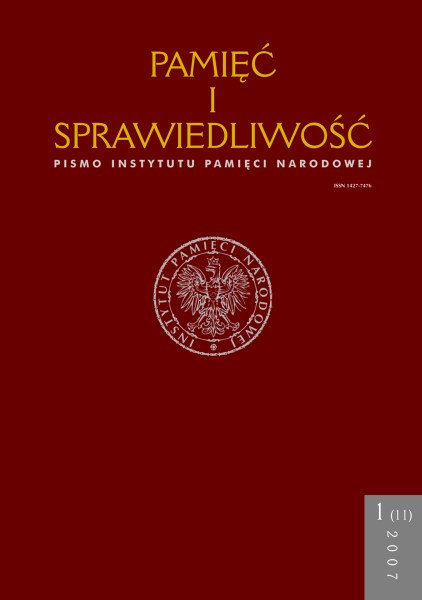Droga do rewolucji
Pamięć i Sprawiedliwość, Tom 11 Nr 1 (2007), strony: 15-31
Data publikacji: 2007-12-30
Abstrakt
The main reason for the revolution which broke out in 1956 was the communist party itself. Until 1953 it opposed almost all the Hungarian society, the living standards of which was being lowered gradually since 1948. Income of most of the labourers
was scarcely enough to cover the every day needs. Levelling the differences within the society was made only in the lowest class. Life conditions of most of the nation were worse. Living standards were lowered most for intellectuals (apart from those working for the communist authorities). In the country the conditions were even worse. Socialistic reforms of the agriculture, compulsory collectivisation led to lowering incomes of this social group. The regime could survive only because of the common terror and smashing the society, particularly by ÁVH (State Security Services)
activities, which controlled the society with the developing net of agents. The change was made in the middle of 1953 when Mátyás Rákosi was dismissed, and Imre Nagy gained the power. His government led to serious changes in the inner policy. The most important steps were cleaning the atmosphere which had been soaked with terror. Nagy closed internment camps, stopped resettlements, and many of prisoners were liberated. He desisted from some investments in the heavy industry, which allowed for transferring the money to other branches of industry. Reducing condingents of compulsory supplies of farm produce led to improvement in food deliveries.
The aim and the main task of Rákosi and ÁVH was stopping or slowdown or at least keeping control over the process of revision and rehabilitation. The process of division of the party began, which was the reason of disintegration of this monolitic structure into two parts. In the beginning of 1955 Rákosi with the help of Moscow could get rid of Nagy. In spring 1955 he was dismissed from the post of the prime minister. From the beginning of 1955 Rákosi tried to restore the previous order, and it was necessary to re-unite the party. Hungarian party authorities condemned the policy led from 1953. The investigation in the case of Rajk death and the reveal of the role that Rákosi played in it led to his dismissal in July 1956. Moscow chose the worst possible successor, that is Ernő Gerő. He was trying to stabilise the situation in the country and to close the past with no purges.
He announced democratisation of the socialist system, but he did not do much to achieve it. Rehabilitation activities were such a big challenge for ÁVH, that it had less time to fi ght the enemy. In the name of restoring the law order they had to resign from surveiling political leaders. Thus there was a danger that it would loose its political power. The revision of Rajk case started a hail of events. The party leaders on the state level were not able to face the real problems, they were not even able to start the process of seeking for resolution. The activities taken were wrong and too slow. The party started to fall. At the local party level more and more members started to accept reforms.
Inne teksty tego samego autora
- David Silberklang, Aleksandra Matulewska, Refleksje na temat losu Żydów w okupowanej Polsce 1939–1945 , Pamięć i Sprawiedliwość: Tom 12 Nr 1 (2008)
- Vasile Palii, Mihai Retegan, Aleksandra Matulewska, Rumunia wobec Praskiej Wiosny , Pamięć i Sprawiedliwość: Tom 11 Nr 1 (2007)
 Język Polski
Język Polski
 English
English
 Deutsch
Deutsch
 Français (France)
Français (France)
 Italiano
Italiano
 Русский
Русский


 PDF
PDF
